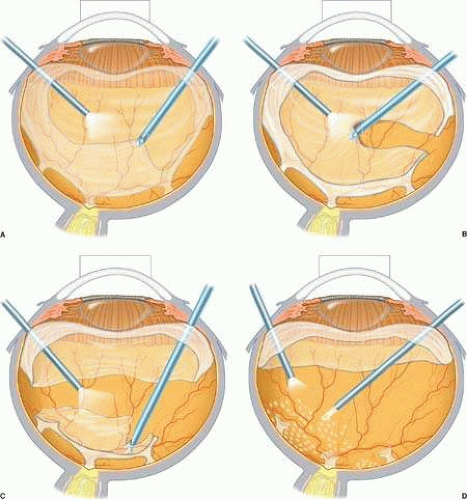Surgery for the back part of the eye is called pars plana vitrectomy. For example vitrectomy may be part of the treatment plan for.
 Northern California Advanced Surgery Center Vitrectomy Surgery
Northern California Advanced Surgery Center Vitrectomy Surgery
A vitrectomy is a surgical procedure that is performed to remove the clouded vitreous gel in the center of the eye.

Diabetic retinopathy vitrectomy. In addition the following ophthalmological parameters were collected. VITRECTOMY FOR PDR Advances in retina surgical instrumentation eg for 25-gauge 25 and 23-gauge surgery improved lighting and more sophisticated vitrectomy systems have enhanced our ability to handle complicated cases of diabetic retinopathy. Retinal detachment by helping your doctor repair any holes or tears in the retina Diabetic retinopathy by replacing cloudy vitreous and helping your doctor find and repair sources of bleeding in the retina.
High blood sugar damages retinal blood vessels. Retinal detachment remains the most common indication for vitrectomy in proliferative diabetic retinopathy accounting for 489 of surgery 374 TRD 115 CTRD compared with 431 for non-clearing vitreous haemorrhage5 The timing of surgery is strongly influenced by the aetiology of the detachment and the proximity to the macula. Outcome parameters describing the visual system function were defined and applied to quantitate the effect on visual system disability.
Early vitrectomy is recommended for eyes with severe vision loss from non-clearing VH of at least 1 months duration in patients with type 1 DM or in monocular patients regardless of the type of diabetes. Vitrectomy Surgery for Diabetic Retinopathy Preventing vision loss from diabetic retinopathy If you have diabetes talk with your primary care doctor about controlling your blood sugar. The authors review the indications techniques and results of vitrectomy in the management of diabetic retinopathy.
Mortality data for all patients were retrieved from the Dutch population register. Proliferative diabetic retinopathy PDR is one of the most common cause of vision loss in diabetic patients and the incidence age of PDR patients gradually gets younger. To analyse the influence of renal function on the outcomes of vitrectomy for tractional-related complications in cases of severe proliferative diabetic retinopathy PDR.
Many such eyes may be helped by vitrectomy surgery however. It appears that in select cases PPV may improve DME and improve visual acuity with potentially long-lasting effects. Additionally the Diabetic Retinopathy Vitrectomy Study showed a benefit to early intervention in patients with type 1 diabetes as these patients tend to have more quickly progressing retinopathy and delay of adequate PRP may lead to the development of fibrovascular proliferation and increased risk of retinal detachment.
This diabetic retinopathy treatment has a very high success rate for improving vision. Many recent studies have focused on the possible benefits of pars plana vitrectomy PPV for the treatment of diabetic macular edema DME. Early vitrectomy is also recommended for eyes with advanced active PDR particularly when extensive NV is present.
Retrospective consecutive case series of 109 eyes that underwent vitreoretinal interventions for traction-related complications of severe PDR from 2014 to 2017. Although vitrectomy improves the prognosis for a favorable visual outcome preventive measures such as improved control of glucose levels and timely application of panretinal photocoagulation produce better results. Vitrectomy can help doctors treat several different eye conditions.
Anterior vitrectomy involves the front parts of the eye. As a greater understanding of the pathophysiology of diabetic eye disease has developed so the role of PPV has evolved. To quantitate the effect of diabetic vitrectomy on each patients visual system and function.
This study aims to compare the characteristics of PDR and outcomes following vitrectomy in. 4 About 5 percent of patients with proliferative diabetic retinopathy as well as carefully selected patients with diabetic maculopathy require pars plana vitrectomy despite ostensibly adequate laser treatment and good glycemic and hypertensive control. Pars plana vitrectomy PPV is integral to the management of late complications in diabetic retinopathy.
The anatomic and visual acuity outcomes of diabetic vitrectomy among three surgeons at one institution over a 4-year time interval were studied. Lens status indication for vitrectomy diabetic retinopathy DR stage in the fellow eye during the time of vitrectomy and prior treatment with panretinal photocoagulation or antiVEGF. Vitrectomy may be necessary to treat conditions and diseases such as macular hole excessive eye floaters proliferative diabetic retinopathy retinal detachment and trauma.
Your doctor may recommend vitrectomy surgery if you have a hemorrhage that doesnt clear if you have retinal detachment or if laser treatment doesnt sufficiently halt the growth of. Vitrectomy may not only remove vitreous hemorrhage but also prevent or relieve traction on the retina from contraction of the fibrovascular membranes that. The gel is replaced with a solution that is similar to the makeup of healthy clear vitreous matter.
